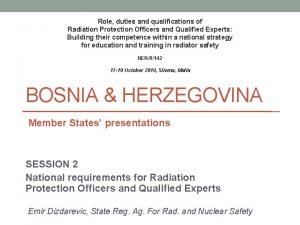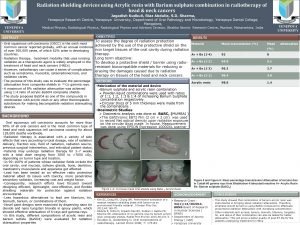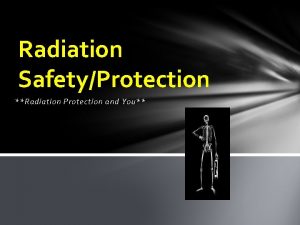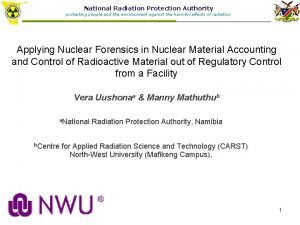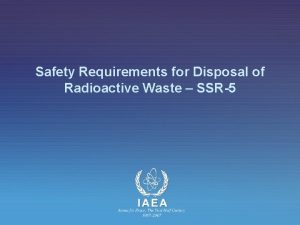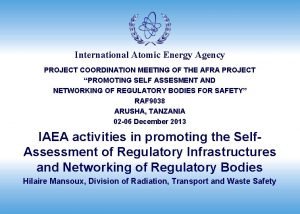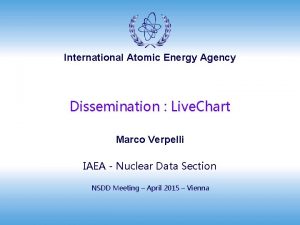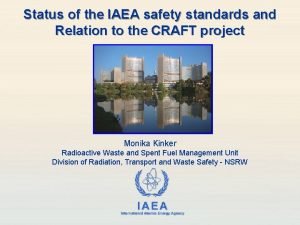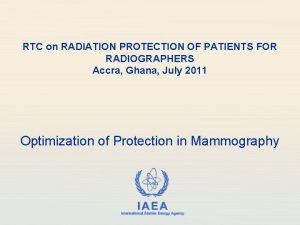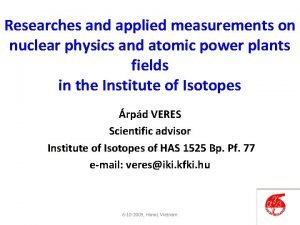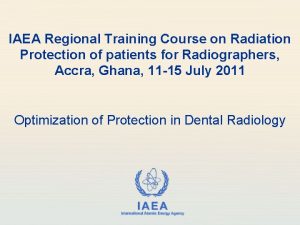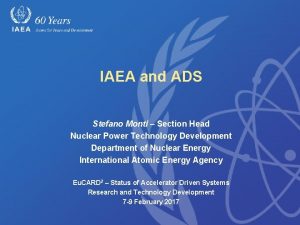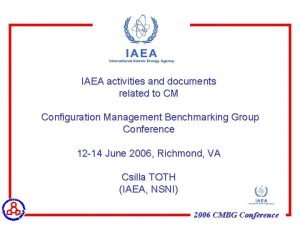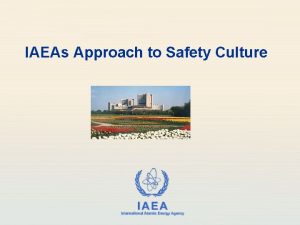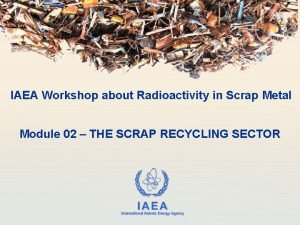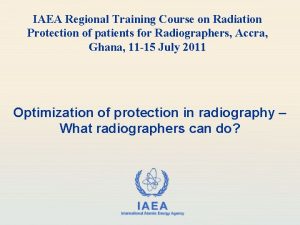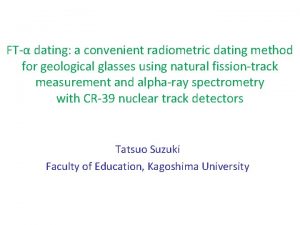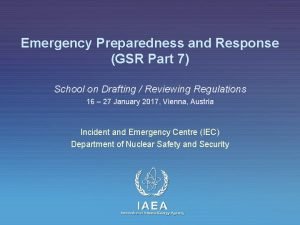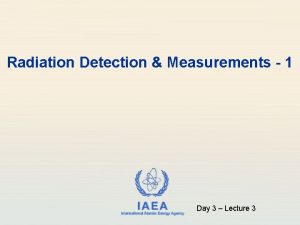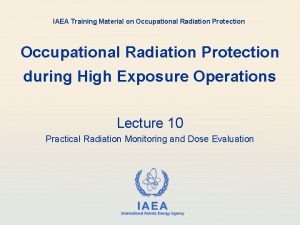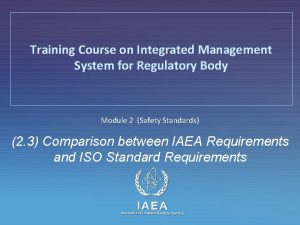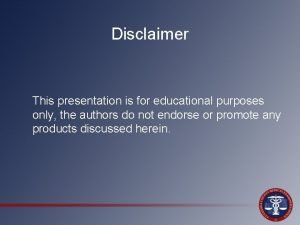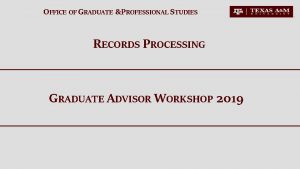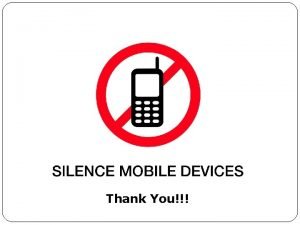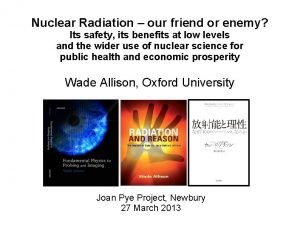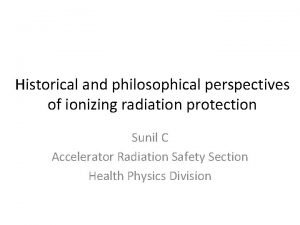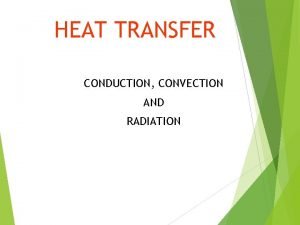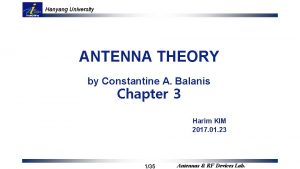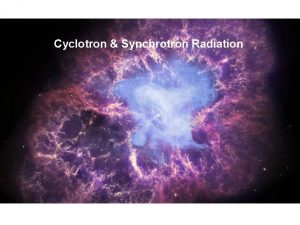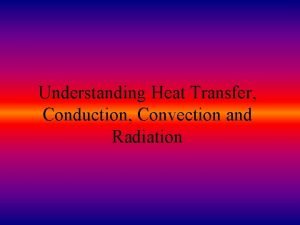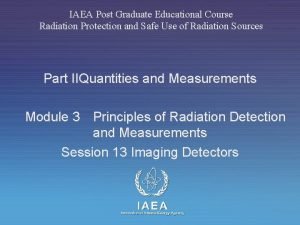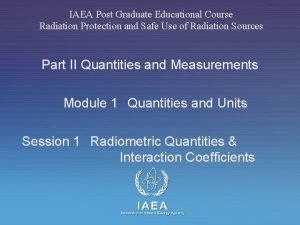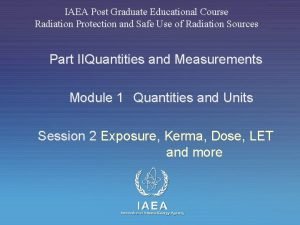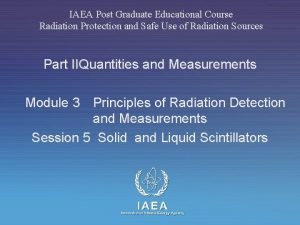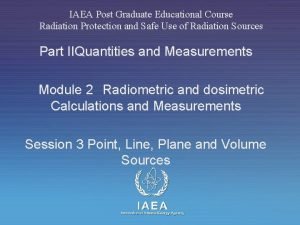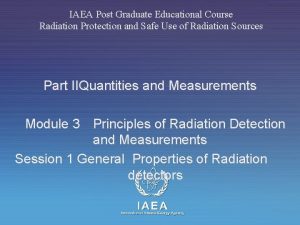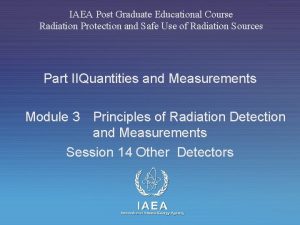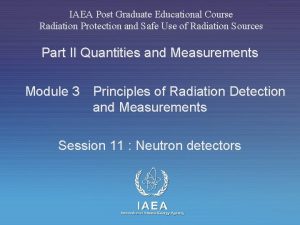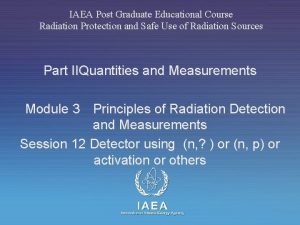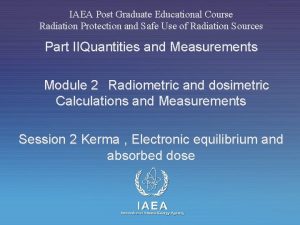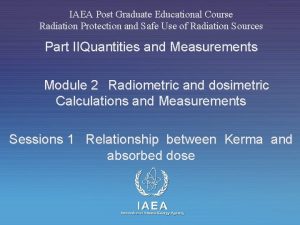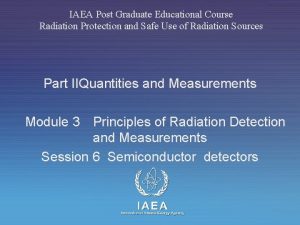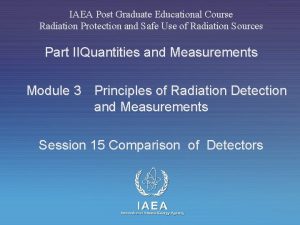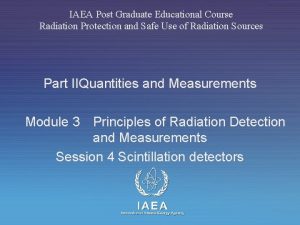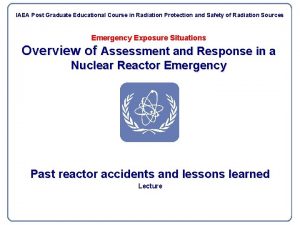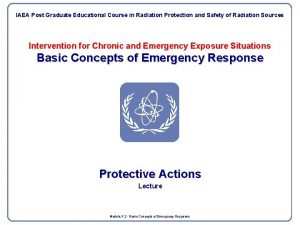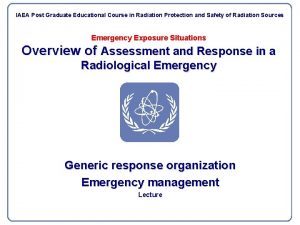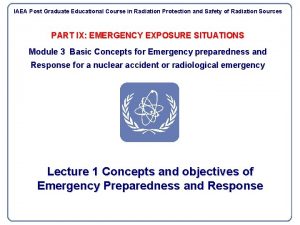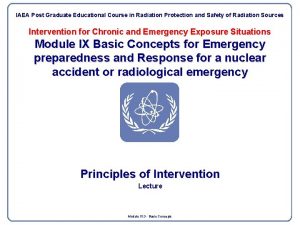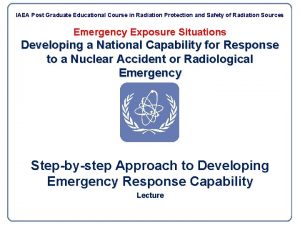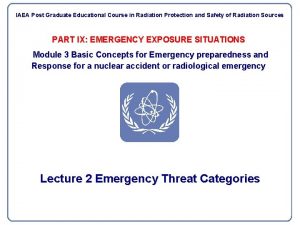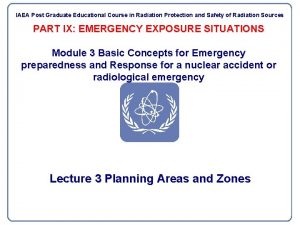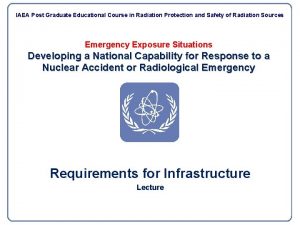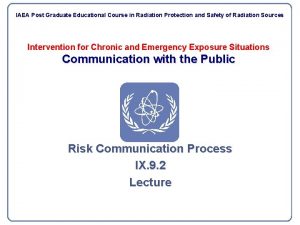IAEA Post Graduate Educational Course Radiation Protection and








































- Slides: 40

IAEA Post Graduate Educational Course Radiation Protection and Safe Use of Radiation Sources Part IIQuantities and Measurements Module 3 Principles of Radiation Detection and Measurements Session 3 Ionization Chambers IAEA International Atomic Energy Agency

Overview • In this session we will discuss the principle of measuring radiation using ionization chambers. IAEA 2

Human Perception As humans, we are virtually incapable of detecting the presence of radiation. Individuals who have been exposed to high levels of radiation have reported feeling “a burning sensation” in their eyes, nausea, dizziness and other symptoms, however, these symptoms have all resulted from exposure to lethal or near lethal doses. Exposure to radiation doses within the occupational exposure dose limits produce no apparent indications of exposure. As a result, we must employ devices to detect and measure radiation. IAEA 3

Interaction with Matter Types of Interactions with natter are: ü Excitation ü Ionization Media in which the interactions can occur are: ü ü ü IAEA Solid Liquid Gas 4

Ion Chamber Ion chambers are the simplest of all gas filled detectors An electric field is used to collect all the ionizations (positive and negative charged particles) produced by the incident radiation in the gas volume IAEA 5

“W” Factor In most gases, the energy needed to ionize the least tightly bound electrons is 1020 e. V however, the “average” energy is higher since some energy is lost in “nonionizing” encounters W value (e. V/ion pair) Gas Fast Electrons Alphas CH 4 30. 2 29. 0 O 2 32. 2 He 32. 5 31. 7 Air 35. 0 35. 2 N 2 35. 8 36. 0 H 2 38. 0 37. 0 (typically 30 -35 e. V/ion pair) IAEA 6

Free Electrons The current (flow of free electrons) is directly related to the radiation intensity. If recombination of free electrons and positively charged atoms is eliminated, then the current flow is a direct measure of the amount of radiation incident on the chamber IAEA 7

Regions of a Gas Filled Chamber Recombination Region IAEA 8

Operating Regions of a Gas Filled Detector Recombination Ionization Proportional Limited Proportional Geiger Mueller IAEA Continuous Discharge 9

Free Air Chamber IAEA 10

Electronic Equilibrium This is what we see; a thin walled chamber full of air IAEA Based on the densities of the materials, this is what the photon radiation sees; a massive block of material surrounding a small volume of air 11

Electronic Equilibrium Photon Energy (Me. V) Density Thickness (g/cm 2) 0. 02 0. 0008 0. 05 0. 0042 0. 1 0. 014 0. 2 0. 044 0. 5 0. 17 1 0. 43 2 0. 96 5 2. 5 10 4. 9 IAEA 12

Free Air Chamber IAEA 13

Ion Chamber Measurements Dose rate meters measure the operational quantity of ambient dose equivalent rate For most applications, this measurement gives a good approximation of the effective dose rate to our bodies IAEA 14

Condenser R Chamber IAEA 15

Condenser R Chamber IAEA 16

Ion Chamber IAEA 17

Ion Chamber IAEA 18

Ion Chamber IAEA 19

Ion Chamber IAEA 20

Ion Chamber IAEA 21

Pressurized Ion Chamber Model 450 non-pressurized IAEA Model 450 P pressurized Model PIC-6 pressurized 22

Extrapolation Chamber Bohm Model 2535 IAEA 23

Extrapolation Chamber IAEA 24

Geiger Tube as Exposure Meter • “Exposure” is the parameter measuring the ionization of air. • Geiger tube measures ionization pulses per second - a “count rate”. • The number of ionizations in the Geiger tube is a constant for a particular energy but is energy dependent. IAEA 25

COMPENSATED GEIGER DOSE RATE METERS • GMs have a high sensitivity but are very dependent upon the energy of photon radiations. • The next graph illustrates the relative response (R) of a typical GM vs photon energy (E). • At about 60 ke. V the response reaches a maximum which may be thirty times higher than the detector’s response at other radiation energies. IAEA 26

Energy Response of GM – Uncompensated R 20 1. 2 1. 0 0. 8 10 IAEA 1000 E, ke. V 27

COMPENSATED GEIGER DOSE RATE METERS • GMs have a high sensitivity but are very dependent upon the energy of photon radiations. • The next graph illustrates the relative response (R) of a typical GM vs photon energy (E). • At about 60 ke. V the response reaches a maximum which may be thirty times higher than the detector’s response at other radiation energies. IAEA 28

COMPENSATED GEIGER DOSE RATE METERS • Detector’s poor energy response may be corrected by adding a compensation sheath • Thin layers of metal are constructed around the GM to attenuate the lower photon energies, where the fluence per unit dose rate is high, to a higher degree than the higher energies. • The modified or compensated response, shown as a dashed line on the next graph, may be independent of energy within ± 20% over the range 50 ke. V to 1. 25 Me. V. • Compensation sheaths also influence an instrument’s directional (polar) response and prevent beta and very low energy photon radiations from reaching the Geiger tube. IAEA 29

Energy Response of GM – Uncompensated and Compensated R 20 1. 2 1. 0 0. 8 10 IAEA 1000 E, ke. V 30

Example Polar Response IAEA 31

Example of Compensated GM Rad. Eye component IAEA International Atomic Energy Agency

Rad. Eye • Pocket meter • low power components • automatic self checks • essential functions accessed while wearing protective gloves. • Alarm-LED can be seen while the instrument is worn in a belt-holster. • Instrument also equipped with a built in vibrator and an earphone-output for silent alarming or use in very noisy environment. • Number of optional components IAEA 33

Rad. Eye • Options • Rad. Eye PRD - High Sensitivity Personal Radiation Detector • The Rad. Eye PRD is 5000 - 100000 times more sensitive than typical electronic dosimeter. • The Rad. Eye PRD uses Natural Background Rejection (NBR) technology. It is the only instrument of its type and size to achieve this. IAEA 34

Rad. Eye • Options • Rad. Eye G - Wide Range Gamma Survey Meter for Personal Radiation Protection • linearity over 6 decades of radiation intensity: from background level to 5 R/h • overrange indication up to 1000 R/h. • Rad. Eye G incorporates a large energy compensated GM-tube for dose rate measurement for gamma and x-ray. • NBR = Natural Background Rejection The NBR measurement technology has been developed by Thermo Electron for the supression of alarms caused by variations of the natural background. IAEA 35

Sample Ionization Chambers Bicron RSO 50 E Five linear ranges: 0 -5 m. R/h to 0 -50 R/h Energy range 12 ke. V to 7 Me. V Weight only 1. 4 kg A compact, rugged, lightweight ion chamber dosemeter for beta, gamma and X-ray detection and measurements of superficial or deep doses in pulsed or static fields. True electronic range switching is included, avoiding reed switches and their susceptibility to magnetic fields. The 1000 mg/cm 2 shutter makes deep dose versus shallow dose measurements routinely possible. IAEA 36

Sample Ionization Chambers Eberline Model RO 2 DETECTOR Five linear ranges: 0 -5, 0 -500 m. R/hr; 0 -5, 0 -50 R/h Air filled ionization chamber vented to atmosphere Detector Volume 13. 4 in 3 1, 000 mg/cm 2 walls Chamber window 7 mg/cm 2 Beta shield 1, 000 mg/cm 2 30% from 8 ke. V to 6 Me. V 15% from 33 ke. V to 6 Me. V EXTERNAL CONTROLS Rotary switch for Off, Battery check, Zero, 5, 500 m. R/h; 5 -50 R/h Zero knob PHYSICAL Size: 20. 1 x 10. 7 x 19. 6 cm Weight: 1. 6 kg IAEA 37

Sample Ionization Chambers Eberline Model RO 2 IAEA

Sample Ionization Chambers Eberline Model RO 2 Chambers must calibrated prior to use IAEA

Sample Ionization Chambers Victoreen Model 440 RF/D The 440 RF/D is a highly sensitive, low energy, RF shielded survey meter suited for fast, accurate measurements of background and other low radiation levels. It is the basis of measurement for radiation exposure in the color television industry. This instrument is also used to measure radiation from radar and transmission towers where RF may be present. Internal software-controlled pressure transducer and temperature sensor automatically apply standard air density correction factors from 70 to 106 k. Pa to the unsealed ion chamber IAEA Range ( Sv/hr) Response (sec) 0 -10 7 0 -30 7 1 -100 5 0 -300 5 0 -1000 5 40
 Radiation protection officer qualifications
Radiation protection officer qualifications Barium sulphate board for radiation protection
Barium sulphate board for radiation protection Cardinal principles of radiation protection
Cardinal principles of radiation protection National radiation protection authority namibia
National radiation protection authority namibia Ssr5
Ssr5 Saris iaea
Saris iaea Livechart iaea
Livechart iaea Succequent
Succequent Iaea gsr part 4
Iaea gsr part 4 Rtc protection film
Rtc protection film Nuclear wastes
Nuclear wastes Iaea
Iaea Stefano monti iaea
Stefano monti iaea Iaea
Iaea Iaea
Iaea Steel scrap
Steel scrap Iaea
Iaea Iaea
Iaea Gsr part7
Gsr part7 Pcmf
Pcmf Film badge
Film badge Iaea
Iaea Gsr part 2
Gsr part 2 This is for educational purposes only disclaimer
This is for educational purposes only disclaimer Course title and course number
Course title and course number Integration
Integration Half brick wall in stretcher bond
Half brick wall in stretcher bond Course interne course externe
Course interne course externe Office of graduate and professional studies
Office of graduate and professional studies Educational psychology meaning concept and nature
Educational psychology meaning concept and nature How does heat energy flow
How does heat energy flow Thank you
Thank you Venn diagram of solids liquids and gases
Venn diagram of solids liquids and gases For parents and friends radiation threat
For parents and friends radiation threat Ionizing radiation examples
Ionizing radiation examples What is heat transfer conduction convection and radiation
What is heat transfer conduction convection and radiation Conduction convection radiation examples
Conduction convection radiation examples Radiation integrals and auxiliary potential functions
Radiation integrals and auxiliary potential functions Synchrotron radiation
Synchrotron radiation Venn diagram of conduction, convection and radiation
Venn diagram of conduction, convection and radiation Conduction in water
Conduction in water
